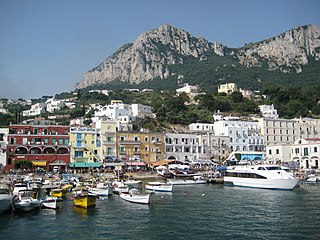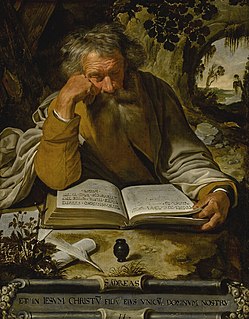Related Research Articles
The 330s decade ran from January 1, 330, to December 31, 339.

Sorrento is a town overlooking the Bay of Naples in Southern Italy. A popular tourist destination, Sorrento is located on the Sorrentine Peninsula at the south-eastern terminus of the Circumvesuviana rail line, within easy access from Naples and Pompeii. The town is widely known for its small ceramics, lacework and marquetry (woodwork) shops.

Capri is an island located in the Tyrrhenian Sea off the Sorrento Peninsula, on the south side of the Gulf of Naples in the Campania region of Italy. The main town Capri that is located on the island shares the name. It has been a resort since the time of the Roman Republic.
Constantius may refer to:
Nikephoros Blemmydes was a 13th-century Byzantine author.

Villar San Costanzo is a comune (municipality) in the Province of Cuneo in the Italian region Piedmont, located about 70 kilometres (43 mi) southwest of Turin and about 15 kilometres (9 mi) northwest of Cuneo. As of 31 August 2007, it had a population of 1,474 and an area of 19.5 square kilometres (7.5 sq mi).
The island of Capri is situated in the Gulf of Naples, between the Italian Peninsula and the islands of Procida and Ischia. Made of limestone, its lowest part is at the center, while its sides are high and mostly surrounded by steep precipices, which contain numerous caves. Its topography is dominated by the slopes of the Monte Solaro in the West and Monte San Michele the East.

Capri is a municipality, in the Metropolitan City of Naples, situated on the island of Capri in Italy. It comprises the centre and East of the island, while the West belongs to Anacapri.
Saint Chiaffredo is venerated as the patron saint of Saluzzo, Italy. Tradition considers him a member of the Theban Legion, but instead of being martyred with this legion at Agaunum, he escaped to Piedmont and was martyred there.

Saint Constantius is venerated as a member of the legendary Theban Legion. Similar to the cults of Saint Chiaffredo at Crissolo, Saint Bessus at Val Soana, Saint Tegulus at Ivrea, Saint Magnus at Castelmagno, and Saint Dalmatius at Borgo San Dalmazzo, the cult of Saint Constantius was linked with that of the Theban Legion to lend antiquity to a local saint about whom nothing was really known.

Amalfi Cathedral is a medieval Roman Catholic cathedral in the Piazza del Duomo, Amalfi, Italy. It is dedicated to the Apostle Saint Andrew whose relics are kept here. Formerly the archiepiscopal seat of the Diocese of Amalfi, it has been since 1986 that of the Diocese of Amalfi-Cava de' Tirreni.

Andrew the Apostle, also called Saint Andrew, was an apostle of Jesus according to the New Testament. He is the brother of Saint Peter. He is referred to in the Orthodox tradition as the First-Called.
Saint Constantius of Aquino was a bishop of Aquino in Italy, noted for his gift of prophecy, and a saint. He is commemorated in the Roman Martyrology on Sept. 1.

Marina Grande is the main port of the island of Capri in Italy, to the north of the main town of Capri and at the foot of Mount Solaro.

The Chiesa di San Costanzo is a monumental church of Capri. Named after the patron saint of the island of Capri, San Costanzo, it was the cathedral of the Roman Catholic Diocese of Capri from 987–1560.

Marina Piccola is located on the southern side of the island of Capri. It is near the Faraglioni sea stacks to the southeast. The Via Krupp is a historic switchback paved footpath which connect the Charterhouse of San Giacomo and the Gardens of Augustus area with Marina Piccola. The Marina Piccola, used by Augustus and Tiberius, preceded the Marina Grande.

Piazza Umberto I is the most famous square of the island of Capri, Italy. The square is located in the historic center of Capri, in the eponymous town Capri, on the eastern end of the island, and since Roman times, it has been considered the center of the town and the meeting point of the island by both residents and others.

Santo Stefano is a Catholic church and former cathedral on the island of Capri, Italy. Dedicated to Saint Stephen, it is the principal house of worship in the town of Capri. The religious complex was built around the Piazza Umberto I square in the seventeenth century. The archbishop's palace is now used as the town hall ("Municipio"). Santo Stefano and Chiesa di San Costanzo are the island's two oldest churches.

JK Place Capri is a luxury boutique hotel on island of Capri. It is located in the northeast of Anacapri town, towards the northwest of the island and west of Marina Grande. Established in 2007, the hotel has 22 rooms, and eight suites, and is situated in a restored late 19th century villa which once belonged to wealthy American sisters Sadiee and Kate Woolcott-Perry.
Chiesa di Sant'Andrea is a church in the island of Capri, Italy, near the Marina Piccola in the south. It was built in 1900 for the local fishermen. The site which the church lies on formerly contained a watch tower which was used as a lookout post for invading Saracen pirates. The church was designed by the painter Riccardo Fainardi, and funded by German banker Hugo Andreae and his wife, Emma.
References
- ↑ "Constantius <de Capri>". Consortium of European Research Libraries . Retrieved 5 July 2012.
- ↑ Constantius of Capri is undocumented, but may be the same as Constantine I, Patriarch of Constantinople - see Santiebeati.it: San Costanzo di Capri.
- 1 2 Douglas, Norman (1952). Footnote on Capri. Sidgwick and Jackson. p. 19. Retrieved 5 July 2012.
- ↑ A. Hofmeister, "Aus Capri und Amalfi: Der Sermo de virtute und der Sermo de transito s. Constantii und der Sarazenenzug von 991" , 1922).
- 1 2 Andrén, Arvid (1980). Capri: from the stone age to the tourist age. Paul Åströms förlag. p. 92. ISBN 978-91-85058-98-3 . Retrieved 5 July 2012.
- ↑ Ring, Trudy; Salkin, Robert M.; Boda, Sharon La (1 January 1996). International Dictionary of Historic Places: Southern Europe. Taylor & Francis. pp. 121–. ISBN 978-1-884964-02-2 . Retrieved 4 July 2012.
- ↑ Valdes, Giuliano; Fabbri, Patrizia; Lewis, Rhiannon (May 2009). Capri. Casa Editrice Bonechi. pp. 8–. ISBN 978-88-476-0785-9 . Retrieved 5 July 2012.
- ↑ Santi e beati: "San Costanzo di Capri.